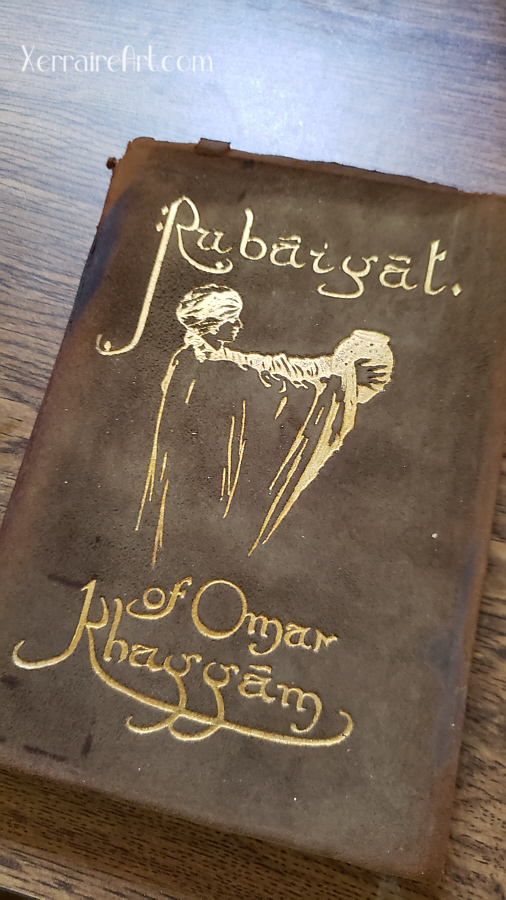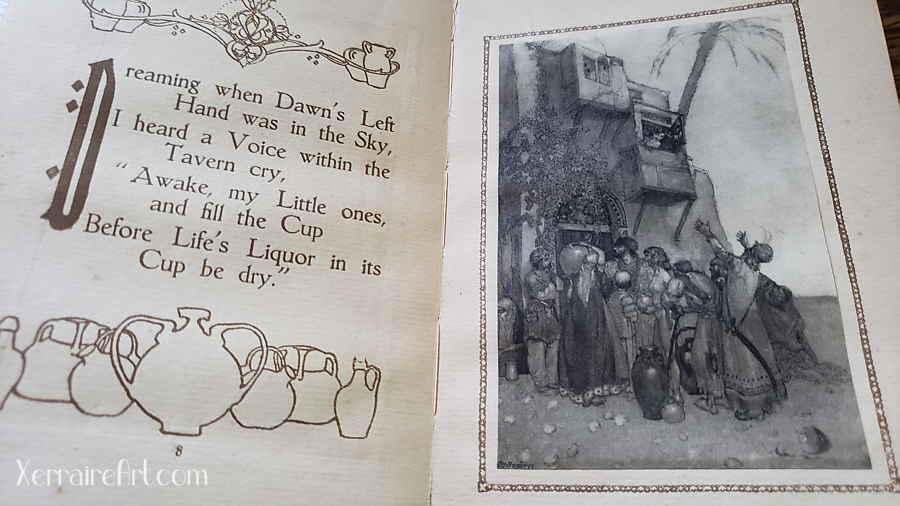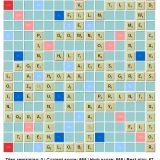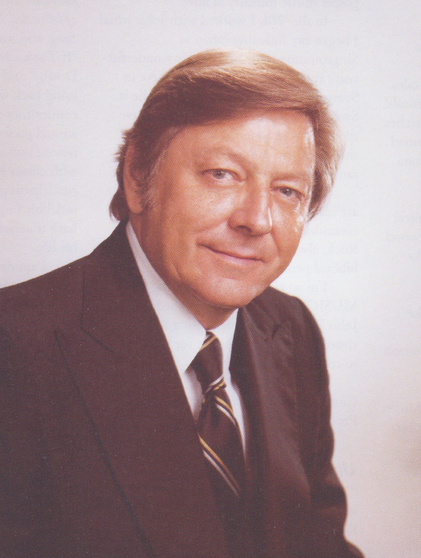Rubáiyát of Omar Khayyám
Mom always had a lot of books, everywhere. They were kept downstairs, in the living room, in her room, and even the extra guest room we had in the house. She also brought home two armloads of books from the library every three weeks.
I remember as a little girl loving to look at one book in particular. It had a cover that felt like velvet, with a gold looking drawing and very funny looking writing.

Rubáiyát of Omar Khayyám velvety cover.

The insides of the book were just as lovely, with it printed on special paper different than most books I had ever seen, with lovely images and drawings.
As an adult, finding it again in her piles of books, I was finally moved to research the writer of this mysterious looking book.
Omar Khayyam has also been called, “the Astronomer-Poet of Persia”.
According to FamousScientists.org, he is remembered for so much more:
In the year 1072 AD, Omar Khayyam documented the most accurate year length ever calculated – a figure still accurate enough for most purposes in the modern world. Khayyam was an astronomer, astrologer, physician, philosopher, and mathematician: he made outstanding contributions in algebra. His poetry is better known in the West than any other non-Western poet.
The man himself remains something of an enigma. Different biographers have documented him as a fun-loving, wine-drinking agnostic; a closet Zoroastrian; a Sufi Muslim; an orthodox Sunni Moslem; and a follower of Ancient Greek philosophy. All agree that he was an outstanding intellectual.
Omar had great achievements in Algebra, Geometry, and Science.
He had to living in hiding for many years, the power struggles, friends made, and not aspiring to any religion much created some enemies. No poetry was published in his lifetime.
Omar Khayyam died at the age of 83 in his hometown of Nishapur on December 4, 1131. He was buried in a tomb whose location he had chosen in an orchard where blossom would fall twice a year.
Khayyam’s poetry was popularized in the 1800s by Edward FitzGerald’s translations in the Rubaiyat of Omar Khayyam. Khayyam became so admired in the West that in 1963 the Shah of Iran had his grave exhumed and Khayyam’s remains moved to a huge purpose-built mausoleum in Nishapur where tourists could pay homage to the great poet.
FitzGerald’s text was published in five editions, with substantial revisions:
- 1st edition – 1859 [75 quatrains]
- 2nd edition – 1868 [110 quatrains]
- 3rd edition – 1872 [101 quatrains]
- 1878, “first American edition”, reprint of the 3rd ed.
- 4th edition – 1879 [101 quatrains]
- 5th edition – 1889 [101 quatrains]
Of the five editions published, four were published under the authorial control of FitzGerald. The fifth edition, which contained only minor changes from the fourth, was edited posthumously after his death on the basis of manuscript revisions FitzGerald had left.
Numerous later editions were published after 1889, notably an edition with illustrations by Willy Pogany, first published in 1909 (George G. Harrap, London). It was issued in numerous revised editions.This edition combined FitzGerald’s texts of the 1st and 4th editions and was subtitled “The First and Fourth Renderings in English Verse”.
The book that we have has illustrations by Willy Pogany, has no indication of a year, only saying it was printed in Great Britain. There is a mention of
New York: Thomas Y. Crowell Company , which doesn’t add up. It almost looks handmade. There is handwriting inside the book, as it must have been a gift to someone in 1928. So the actual book that mom owned is still a mystery to me.
However, the writer and the editions aren’t without controversy either, with some doubting that Omar had even written these verses and that FitzGerald had taken liberties with the translations.
All these years later though, it was sweet to learn just a little more about this book that I had admired so much as a little girl.















